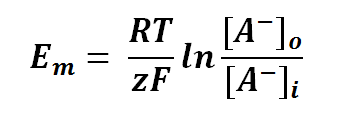Nernst Equation
Nernst Equation is an equation used to calculate the electrical potential of a chemical reaction. In its equilibrium state, the Nernst equation should be zero. It also shows the direct relation between energy or potential of a cell and its participating ions. The equation is proposed by a German chemist, Walther H. Nernst (1864-1941).
Equation
Nernst equation can be expressed as follows:
where
Ecell is the half-cell potential difference
Eθcell is the standard half-cell potential
R is the universal gas constant; R = 8.314471 J K-1 mol-1
T is the thermodynamics temperature, in Kelvin; 0 K = -273.15oC
z is the number of moles of electrons transferred between cells (defined by the valency of ions)
F is the Faraday's constant; F = 96,485.3415 C mol-1
[red] is the concentration of ion that gained electrons (reduction)
[oxi] is the concentration of ion that lost electrons (oxidation)
Membrane Potential
Nernst equation is also can be used to calculate the potential of an ion across the membrane. For potential difference of a membrane, we can manipulate the Nernst Equation as follows:
or
where


